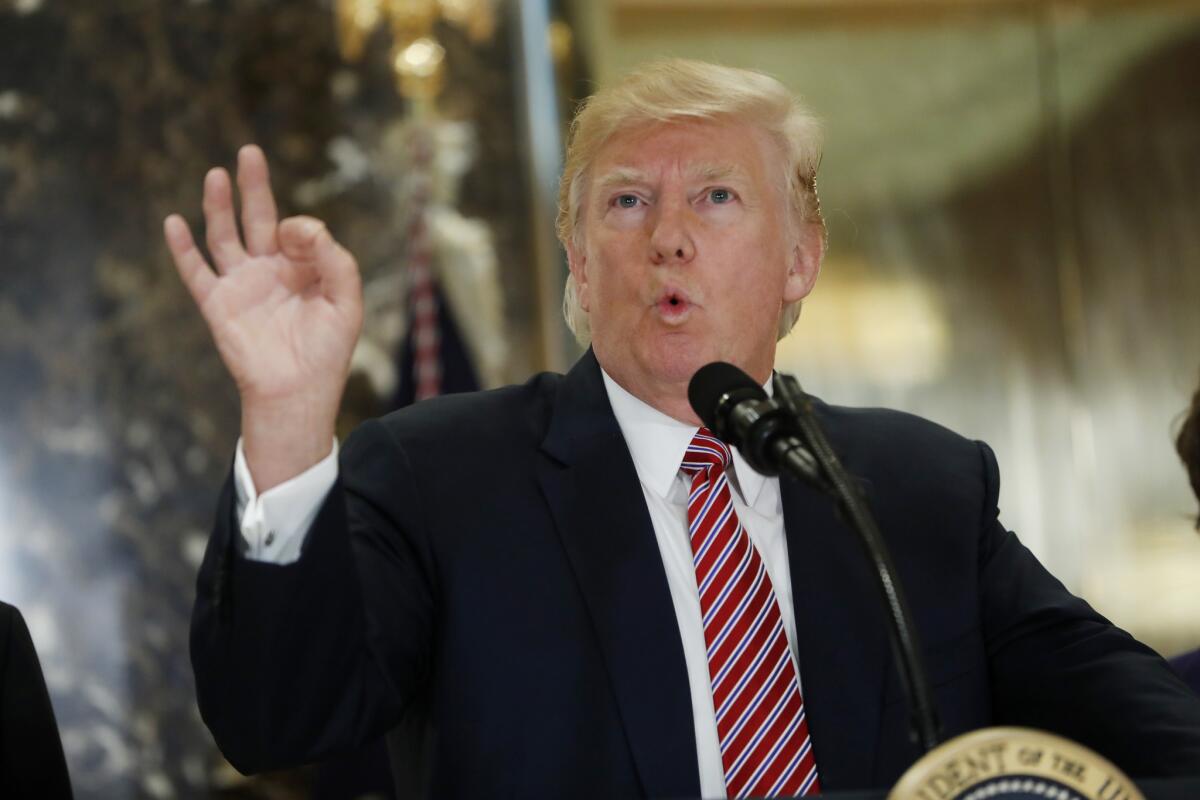Column: Trump says he has a healthcare plan (yeah, sure). I have a better idea

President Trump said he would be “signing a healthcare plan within two weeks, a full and complete healthcare plan.” That was on July 17, about three weeks ago.
Needless to say, there’s been no such signing. Trump now says he may have something to offer by the end of August. “It’s just about completed,” he said this week.
Yeah, whatever. He’s been saying that since the earliest days of his presidency, when he pledged that “we’re going to have insurance for everybody,” with treatment that’s “far less expensive and far better.”
Maybe if Trump set more reasonable goals for himself, we wouldn’t be in this endless cycle of awaiting promised reforms that never materialize.
I’d like to propose a modest step Trump and lawmakers could take right now that wouldn’t fix our dysfunctional healthcare system but would at least make the problems more visible, thus putting us a step closer to solutions.
I’m talking about billing transparency.
I’m talking about making the roughly $4 trillion that Americans spend annually on healthcare more easily understood and requiring healthcare providers to justify their frequently ridiculous charges to patients.
How ridiculous? Here’s just one example.
Will Hertzberg, 69, recently had what he termed a “mini-stroke,” requiring a trip to the emergency room and a 12-hour stay at Kaiser Permanente’s Fontana medical center.
The fee for just entering the ER: $2,481.
The fee to draw six vials of blood and perform lab work: $1,272.
The fee for two CT scans lasting five minutes each: $7,009.
The fee for an electrocardiogram for his heart: $529.
The fee for a handful of pills: $37.
Total cost prior to insurance: $11,328. And note: Hertzberg didn’t even score a bed in a hospital room. He said he spent the entire time on a gurney in an exam room.
“There seems to be no correlation between time taken and fees charged,” the Beaumont resident told me. “It is almost arbitrary billing for whatever amount they want.”
At a cost of about $1,000 an hour in his case, Hertzberg added, “If you don’t have good insurance, you are shafted big time.”
Most Americans, of course, do have insurance, so the list prices of the typical medical bill are much higher than a patient’s out-of-pocket costs.
As a member of Kaiser’s Medicare Advantage plan, Hertzberg said he paid only $90 out of pocket for his treatment.
But those stratospheric list prices on his and others’ bills play a role in raising everyone’s insurance rates to meet higher coverage costs. And for the nearly 30 million Americans who lack health insurance, these prices can be financially devastating.
“Right now, consumers aren’t able to know the cost of a medical procedure or healthcare service until after the service has been rendered and the consumer receives a bill,” said Sophia Tripoli, director of healthcare innovations for the advocacy group Families USA.
“Even then, the actual price of a healthcare service or procedure is hidden behind proprietary contract terms between health plans and providers without any insight into or oversight of those prices by the public,” she told me.
To his credit, Trump has proposed a degree of healthcare-pricing transparency, but it wouldn’t change the landscape much.
Under his plan, which is scheduled to take effect in January 2021, hospitals would be required to disclose the prices they negotiate with insurers for a number of services, as opposed to list prices charged to the uninsured.
They’d also have to create a list of “shoppable” services for elective procedures, allowing patients to compare prices at different facilities.
These aren’t bad ideas, but they don’t accomplish much.
“Healthcare, when you’re having something like a stroke, isn’t something you shop for,” said David Blumenthal, president of the Commonwealth Fund. “You’re taken to the nearest ER.”
The billed prices for procedures in no way reflect actual costs, he told me.
“The prices are set very high because hospitals are anticipating that the insurance companies will negotiate them way down,” Blumenthal said.
A federal judge in June dismissed a legal challenge to Trump’s plan from hospitals. The American Hospital Assn. said it will appeal the ruling.
The thing is, Trump’s transparency plan doesn’t go far enough. What’s needed isn’t a sense of how well hospitals and insurers can haggle over prices, but a clear indication of how much a procedure or treatment really costs to provide.
That is, how much are we being ripped off?
A CT scan, for instance, can run just a few hundred dollars at a private imaging firm. Even factoring in the overhead of a major hospital, it’s quite a stretch to get from $300 at an imaging facility to the $3,500 that Hertzberg was charged for each of his two scans.
Similarly, the $529 he was billed for the ECG to measure his heart rate was many times more expensive than what the test actually costs to administer. A recent study of college athletes by the University of Washington included ECGs that averaged just $130.
The lunacy of our system was highlighted for me by the difficulty I had just finding average prices for various medical services while researching this column. They’re all over the place, and if there’s a central clearing house of honest data, I couldn’t find it.
Is it any wonder that Americans pay more for healthcare than anyone else and about twice what people in other developed countries pay?
Healthcare providers counter that their pricing is too complicated for mere mortals to understand.
They talk of “cost shifting” that allows treatment of the uninsured to be paid in part by those with coverage. They insist their own cost structure is proprietary and thus can’t be revealed for competitive reasons.
Sierra Griffin, a Kaiser spokeswoman, declined to comment on the specifics of Hertzberg’s bill.
“We believe that by listing the full amount, we are helping members be aware of the costs associated with the services they have received, and the portion covered by their health plan,” she said.
“Our prices are based on a variety of factors, all of which relate to our costs for operating an integrated healthcare and coverage system. We regularly check our prices against current healthcare market rates, to help ensure our prices are fair and reasonable.”
Or at least on par with what everyone else is getting away with.
The reality is that the U.S. healthcare market is predicated on keeping patients in the dark so that providers, administrators, suppliers and legions of middlemen can all wet their beaks on people’s medical misfortune.
It’s a system designed to maintain the status quo and to prevent anyone from asking too many questions.
So until our elected officials find the political courage to do what their counterparts in every other developed country have done and enact some form of a single-payer insurance system, I propose simply opening a window and letting in some sunshine.
The Department of Health and Human Services should maintain an easily accessible, easily understood database of medical costs — how much specific tests and procedures cost on average in each state, and the department’s estimate of a fair price.
Healthcare bills should include the government’s fair-price estimate alongside the provider’s list price, with a brief explanation for why the list price is so much higher.
This won’t solve America’s healthcare problems. But it would at least provide a starting point for discussing the issue and, hopefully, shame some providers into placing patients before profits, at least more so than now.
And if medical providers believe their prices are fair, they should have no problem embracing such openness and sharing with patients their straightforward explanations for why bills are so high.
Or could it be that they don’t want us knowing?







